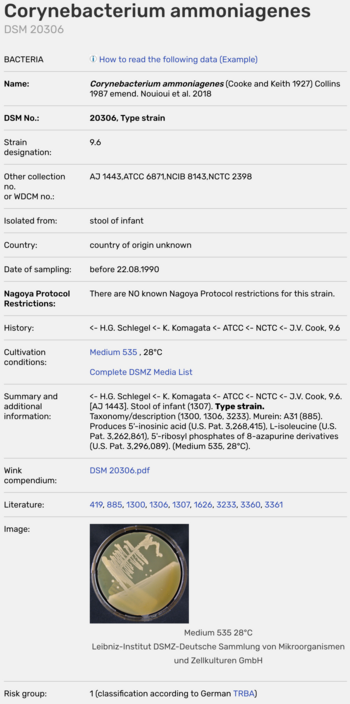Strain Data Arrangement
for the individual strains in the online catalogue
Note: An explanation of the displayed strain data is also available at the detail view of each bioresource.

Name: Correct name of the species, followed by author(s) and year of publication.
Synonym(s), if applicable: The former name(s) of the species.
DSM No.: Taxonomic type strain of the species
Strain designation: The designation(s) given to the strain by scientist(s) who studied it.
Other collection no. or WDCM no.: Accession numbers in other collections (see abbreviations of culture collections of prokaryotes (bacteria) - compiled by J. Euzeby) or number of WDCM Reference Strain Catalogue
Isolated from: Source of isolation according to the data provided by the depositor to the DSMZ and/or according to a publication
History: History of the strain before deposit into the DSMZ. This strain was isolated by J.V. Cook who handed it over the NCTC and so forth.
Cultivation conditions: Culture medium and growth conditions which ensure good recovery and growth of the strain upon receipt. The recipe giving the composition of the media is linked to the media number. Media are not offered by the DSMZ for sale. For hints how to handle specific groups of archaea or bacteria see Culture Technology.
Summary and additional information: Summary and additional information on taxonomic data (e.g. nucleic acid studies, chemotaxonomical data), on production of enzymes or metabolites, on degradation abilities, or on biotechnological applications are given under this heading followed by the reference number(s).
The peptidoglycan (murein) type (here murein A31) of the strain is indicated by a short code developed at the DSMZ (Schumann, P.; 2012). See key table to connect that code with the classification system of peptidoglycans by Schleifer and Kandler (1972).
Wink compendium: The Wink Compendium of Actinomycetales is an electronic manual of the important bacterial class Actinobacteria compiled by Prof. Dr. Joachim Wink (Sanofi-Aventis and University of Braunschweig).
Literature: Links to relevant publication for the selected strain.
Nomenclature used in the catalogue
The scientific names of prokaryotes listed in the catalogue are in accordance with the presently accepted nomenclature in bacteriology. Names are valid only when listed in the "Approved Lists of Bacterial Names" (Skerman et al. 1980; reference 1300) or when validly published since then by an original publication in the Journal of Systematic and Evolutionary Microbiology (IJSEM, up to 1999 International Journal of Systematic Bacteriology), or if published elsewhere and quoted in the "Validation Lists" or "Lists of Changes in Taxonomic Opinion" in the IJSEM. All validly published names are compiled in the List of Prokaryotic names with Standing in Nomenclature. All other names have to be considered as invalid and consequently should be avoided or at least identified as such by using quotation marks.
Nomenclature in this catalogue is based on the actual taxonomic developments. Nevertheless invalid names, validly changed names or synonyms have not been excluded.
The names of fungi and yeasts try to reflect current taxonomic practice, mainly according to MycoBank and following the recommendations published by the IUMS "International Commission on the Taxonomy of Fungi" (Microb. Sci. 3, 168-171 and 285-287, 1986; 5, 23-26, 1988; Mycopathol. 111, 75-83, 1990). In case of recent name changes or misidentification of strains a cross reference to the new designation is included and the former designation is included in the strain's history. No attempt is made to cover all synonyms.

